Input interpretation

cyanogen
Chemical names and formulas

formula | C_2N_2 name | cyanogen IUPAC name | oxalonitrile alternate names | carbon nitride | dicyan | ethanedinitrile | oxalonitrile mass fractions | C (carbon) 46.2% | N (nitrogen) 53.8%
Lewis structure
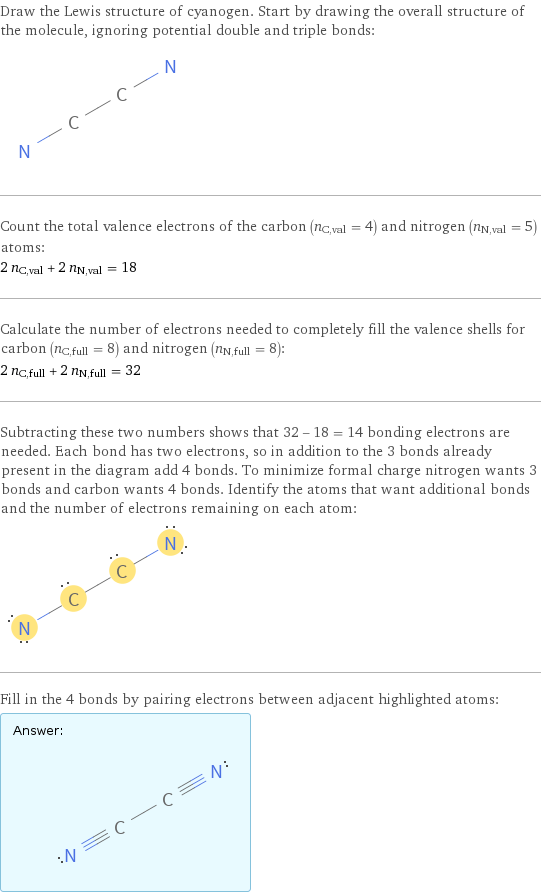
Draw the Lewis structure of cyanogen. Start by drawing the overall structure of the molecule, ignoring potential double and triple bonds: Count the total valence electrons of the carbon (n_C, val = 4) and nitrogen (n_N, val = 5) atoms: 2 n_C, val + 2 n_N, val = 18 Calculate the number of electrons needed to completely fill the valence shells for carbon (n_C, full = 8) and nitrogen (n_N, full = 8): 2 n_C, full + 2 n_N, full = 32 Subtracting these two numbers shows that 32 - 18 = 14 bonding electrons are needed. Each bond has two electrons, so in addition to the 3 bonds already present in the diagram add 4 bonds. To minimize formal charge nitrogen wants 3 bonds and carbon wants 4 bonds. Identify the atoms that want additional bonds and the number of electrons remaining on each atom: Fill in the 4 bonds by pairing electrons between adjacent highlighted atoms: Answer: | |
3D structure

3D structure
Basic properties
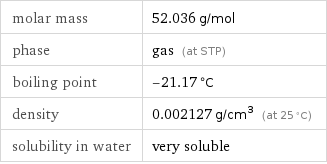
molar mass | 52.036 g/mol phase | gas (at STP) boiling point | -21.17 °C density | 0.002127 g/cm^3 (at 25 °C) solubility in water | very soluble
Units

Gas properties (at STP)

density | 0.002127 g/cm^3 (at 25 °C) vapor density | 1.8 (relative to air) molar volume | 24460 cm^3/mol surface tension | 0.02282 N/m refractive index | 1.00075 dynamic viscosity | 9.8×10^-6 Pa s (at 15 °C)
Units

Thermodynamic properties
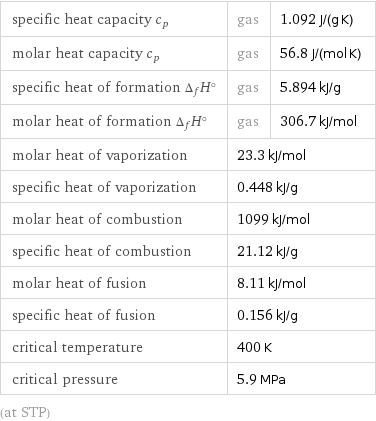
specific heat capacity c_p | gas | 1.092 J/(g K) molar heat capacity c_p | gas | 56.8 J/(mol K) specific heat of formation Δ_fH° | gas | 5.894 kJ/g molar heat of formation Δ_fH° | gas | 306.7 kJ/mol molar heat of vaporization | 23.3 kJ/mol | specific heat of vaporization | 0.448 kJ/g | molar heat of combustion | 1099 kJ/mol | specific heat of combustion | 21.12 kJ/g | molar heat of fusion | 8.11 kJ/mol | specific heat of fusion | 0.156 kJ/g | critical temperature | 400 K | critical pressure | 5.9 MPa | (at STP)
Chemical identifiers
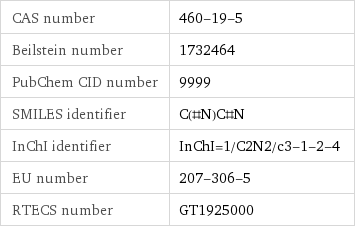
CAS number | 460-19-5 Beilstein number | 1732464 PubChem CID number | 9999 SMILES identifier | C(#N)C#N InChI identifier | InChI=1/C2N2/c3-1-2-4 EU number | 207-306-5 RTECS number | GT1925000
NFPA label

NFPA label
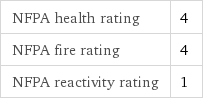
NFPA health rating | 4 NFPA fire rating | 4 NFPA reactivity rating | 1
Safety properties

flash point | -91 °C lower explosive limit | 6% (concentration in air) upper explosive limit | 32% (concentration in air)

DOT hazard class | 2.3 DOT numbers | 1026
Toxicity properties

long-term exposure limit | 20 mg/m^3 (over 8 hours) RTECS classes | human data | primary irritant
Units
